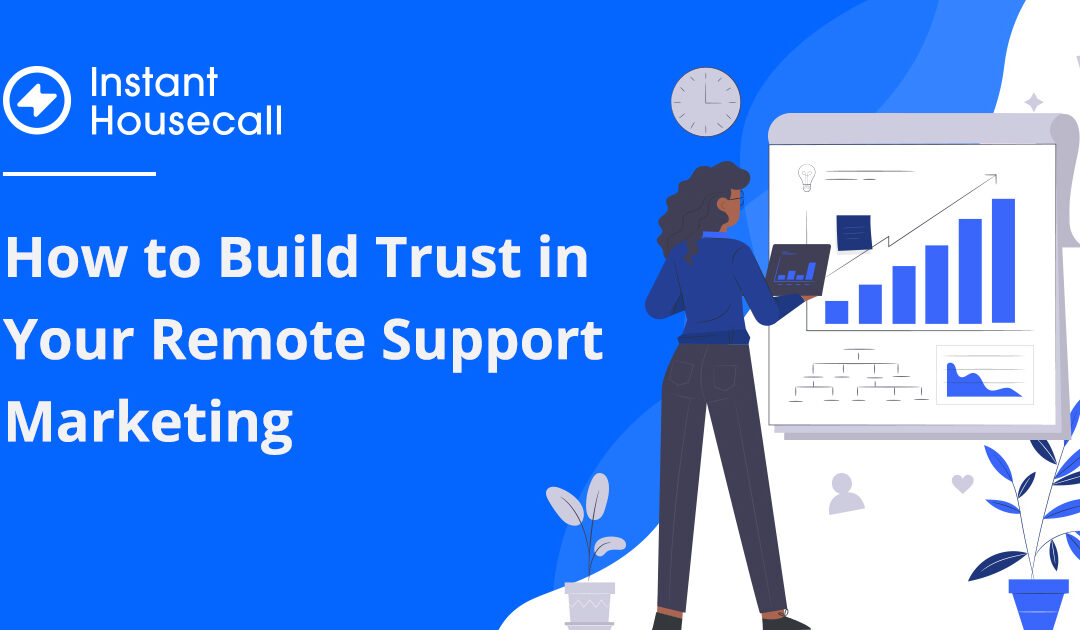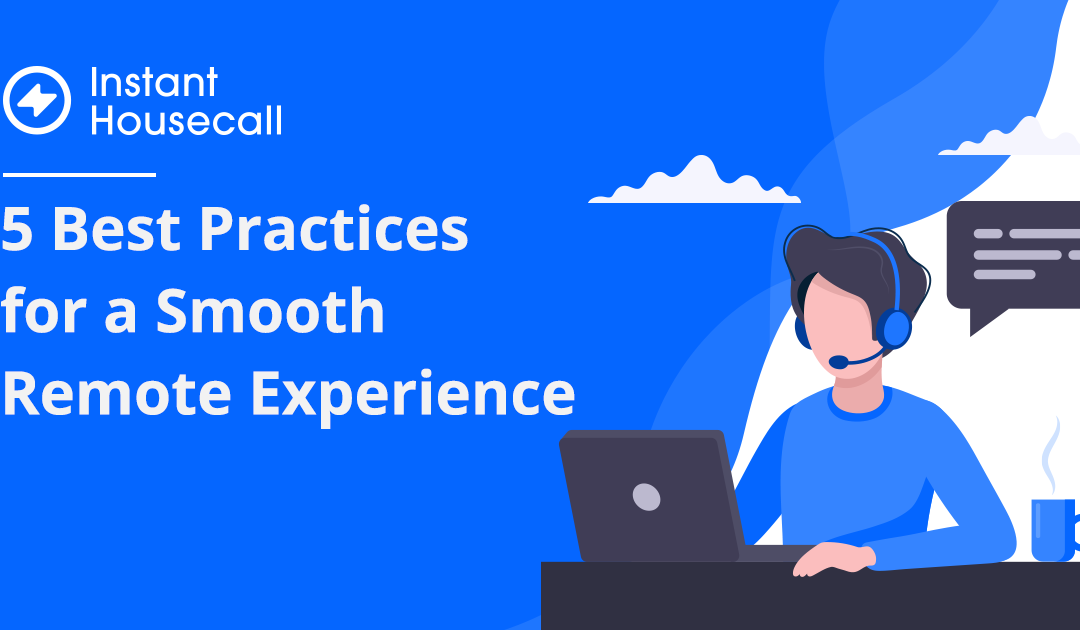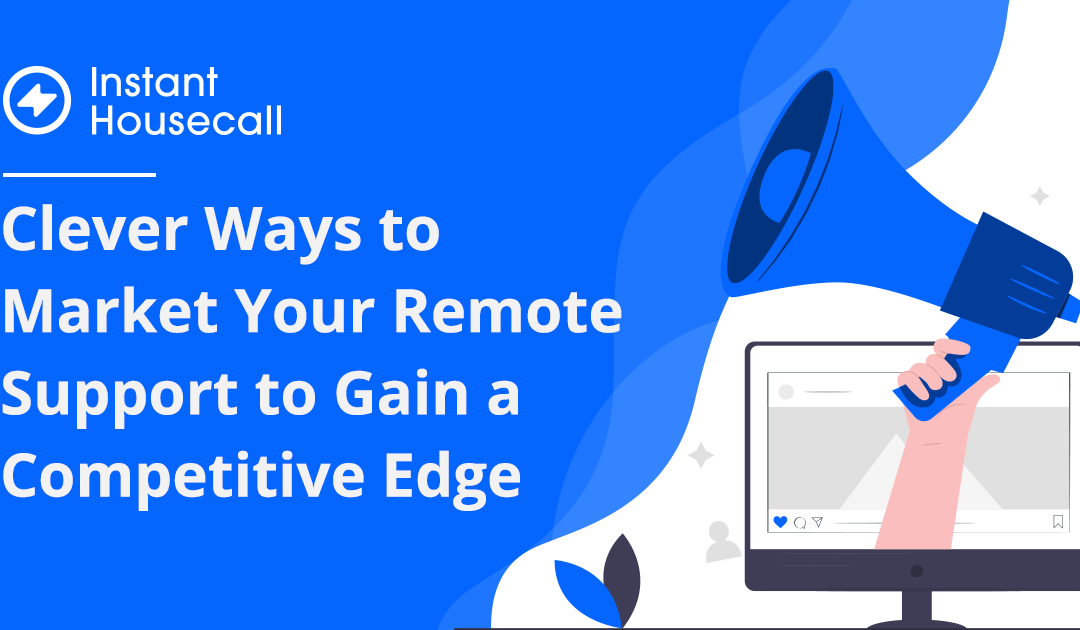
Jun 7, 2021 | Marketing
One thing that can hold people back from using remote support services is that they’re afraid of having someone open a connection to their PC.
They may think, “Is this opening a ‘back door’ that can be used later for stealing my information?” Or… “Are they going to be able to see all my browsing history and personal photos?”
In the case of a business client, they may wonder the same types of things about data security and whether opening a remote portal will somehow leave them at risk, even if it’s not from you, but from a hacker that later finds that portal.
Remote support is only going to grow as a portion of an MSP and IT business owner’s revenue. According to a survey by Gartner, 80% of company leaders plan to allow employees to work remotely at least part-time post-pandemic, and 47% of them plan to enable full-time work-from-home employees.
Tips for Marketing the Safety & Security of Your Remote Support
Marketing your remote support services successfully should include addressing how to let customers know remote support is safe. Getting past this major barrier can keep you from losing potential business and help your company take advantage of the remote working trend.
Highlight the One-Time Connection
You can help alleviate fears that unscrupulous hackers will find your connection “portal” and use it to continue connecting to a PC after the support call by noting how one-time connections work.
When marketing remote support for one-time support calls (not ongoing MSP monitoring) emphasize the “one-and-done” nature of your support software.
When people know that you can only connect one time, unless they give you permission otherwise, it alleviates fears of an ongoing IT security weakness that might cause a breach later.
Use easy-to-understand terms, such as the Time Window. Explain that customers can open up a time window of their choosing for up to 12 hours and that the “portal” closes and can’t be reopened beyond that window.
Address the Remote Support Scam Element
A customer might not come out and say it, but in the back of their mind, they may be wondering about all those “Microsoft support” scams they’ve heard about online. This can cause them to be tentative about contacting you for remote support.
Address the elephant in the room and get it out of the way by including a note on your remote support page that speaks to the differences between your service and those unscrupulous support scams.
Here are some ideas:
- We never call you unsolicited and ask to connect (unlike those scams).
- You can see us in person at our shop, so you know who is assisting you virtually.
- We’ve been a trusted (name of city) fixture for x years (we’re not a stranger).
Promote the Security In Common Terms
It’s important to not just say that you use 256-bit SSL encryption but to explain what that means beyond the “techie term” that a layperson may not know.
For example, you might say, “Our remote support connections use 256-bit SSL encryption, which is one of the most secure encryption methods used worldwide. Hackers would need to guess 256 separate bits of information to try to crack the encryption. According to experts, that would take millions of years to hack.”
Now, you’ve translated the encryption standard into common terms that everyone can understand. Their takeaway is that your remote support can’t be hacked unless a hacker has a few million years to try.
Include Social Proof
No matter what you’re selling, social proof is important. This means having testimonials and quotes from other customers.
78% of people trust online reviews as much as they do a personal recommendation from friends or family. So, adding a quote from a few other customers about how great your remote support is, can make someone else feel better about using it (e.g., “If that accounting firm is okay using their remote support, then I guess it really is secure.”)
Mention Multi-Factor Authentication (MFA)
Another security protocol you want to highlight is multi-factor authentication. If you’re using a tool like Instant Housecall with MFA support, it goes a long way towards alleviating any security concerns about a hacker being able to somehow exploit the remote connection.
Go beyond just saying you use MFA and explain what that means:
“Technicians need to enter a code that is sent only to our company cell numbers before they can log in. This keeps hackers from accessing remote support connections because they don’t have access to the MFA code.”
Use a Remote Support Software With Rock-Solid Security
Instant Housecall remote support software incorporates multiple security standards you can market to your customers, including a time window, 256-bit encryption, and MFA.
Try Instant Housecall risk-free for 15 days and experience it for yourself!

May 17, 2021 | Marketing
In the last 12+ months, remote support has been elevated to a whole new level of importance. The pandemic forced everyone indoors and transformed corporate offices into ghost towns, while employees all worked remotely.
During this time, remote support was often the only way anyone could get hands-on computer assistance.
Some MSPs and IT business owners were prepared for the increase in remote support requests, others weren’t. Those that didn’t do much remote login work, found that they needed to become an expert fast to survive and continue providing vital IT support services to clients.
And it doesn’t look like the newly remote workforce is going anywhere anytime soon (or ever). 67% of businesses say they expect their work-from-home policies to remain in place for the long-term or permanently.
This means that remote support for remote teams will continue to be a need that many businesses have and one that can be one of the main revenue drivers for IT businesses.
Best Practices to Follow for a Great Remote Support Experience
When providing remote support, it’s important to have things go as smoothly as possible so the work is time-efficient for you and a good experience for your customers.
Have a System in Place for a Fast Response
Remember how automotive shops used to advertise the “30-minute oil change?” Now it’s the “10-minute oil change!” People expect support services fast these days and despite having tons of technology tools to make life easier, they seem busier than ever.
When customers request a remote support session, they will expect it to happen fast. In minutes, not hours.
You must respond quickly, otherwise, you can end up losing that customer to a competitor.
Using remote software, like Instant Housecall can allow you to handle more than one support request at a time. Technicians can connect to as many as 10 customer computers concurrently, allowing faster response time without needing to hire additional staff.
Implement & Advertise End-User Privacy & Security
People are generally very aware that anything they do online can put their information at risk. Allowing someone to connect to their computer can leave everything they have on that hard drive exposed, so it takes a lot of trust on a customer’s part.
It’s important to have strong end-user privacy and security systems in place to reduce the risk of a breach of sensitive customer data and to reassure your client that their remote session will be safe.
Some of the standard security practices to have in place are:
- Notification to users before accessing their system
- A disconnection when work is complete, and the inability to reconnect without permission.
- Use multi-factor authentication to secure your remote support account.
- 256-bit SSL encryption to keep data secured
Make sure you’re marketing your remote support services while placing an emphasis on privacy and security.
Chat with Clients While Connected
As a small business owner, you know that there are all types of customers. Some will want you to “just fix it” and they don’t have time to know what you did. Others, want to know all the details and exactly what you are doing to fix a problem.
Having a remote session chat that allows you to connect with the customer directly while you’re attending to their system is important. It allows you to gather more information about the person’s needs and you can also explain what you’re doing to those people interested in knowing more.
A session chat with your remote software also allows you an important audit trail to refer to later if needed.
Unattended Access & Reboot Ability
If you’re using an older remote connection system, you could end up having to call a user that’s stepped away from their computer because the system has disconnected, rebooted, or otherwise locked you out.
This can be a real inconvenience for both you and the customer, and it makes a remote support session take much longer than it needs to.
You want to make sure to use software that gives you the ability to reboot a customer’s computer, even in safe mode, and connect automatically when the PC boots back up. For those customers that have given you unattended permission, you also want to have the ability for unattended access. This provides a level of convenience to customers that can help you stand out over your competition.
Keep an Audit Trail of Everything You Did
Even if you’re connecting remotely and the customer isn’t present, it’s important that you keep a detailed audit trail of all the actions that you took. This can then be emailed to the customer after the session is complete, so they are fully informed of what you did to solve an issue.
This is also an important cover for you should something else unrelated go wrong with their computer later. You’ll have the paper trail to show exactly what you touched and what you didn’t touch.
Try a Remote Support Software With Best Practices Built In
Instant Housecall is a powerful yet easy-to-use remote support software that has multiple best practices built right in for security, multiple connections, and much more.
Try Instant Housecall risk-free for 15 days and experience it for yourself!

May 10, 2021 | Marketing, Small Business
Pre-pandemic, remote support was a helpful option to save an in-person visit. But since the lockdowns during the time of COVID, it has been elevated to a whole new position.
Contactless solutions are now being advertised for everything from grocery shopping to pizza delivery, and remote IT support is the ultimate no-contact solution for getting much-needed computer help.
65% of surveyed U.S. consumers like contactless services and say they align with their current health and safety priorities.
Are you taking full advantage of the features of your remote support service in your marketing?
Many IT providers haven’t changed how they advertise remote support since the pandemic began. It’s still just a tab on their website menu, easily overlooked by someone looking for computer repairs or help with work-from-home employee devices.
If you’re not pushing remote support in new and exciting ways, you can easily miss out on sales opportunities and a chance for recurring remote support business from companies.
Here are several ideas for clever ways to market your report support.
Remote Support for Remote Teams
It’s expected that in 2021, the number of permanent remote employees will double. The work-from-home (WFH) approach is just getting off the ground, and as companies navigate how to make it work at full efficiency, the cost savings will drive this transition.
60% of surveyed executives plan to increase spending on remote team virtual solutions.
Position your firm as a full-service IT partner that can support a WFH team through your remote support services. People more easily remember something if it has a name, so give this particular solution for virtual workers a snappy name (i.e.“Virtual Team Tech Package”).
Create a special page on your website for the service and emphasize things like:
- Use of encryption for security
- Use of multi-factor authentication
- Audit trail for all work done
- X minutes response time
- Boost in productivity when employees don’t have to struggle
- Improvement in the firm’s remote team cybersecurity
Fast, Safe Home & Family Support
The last thing a busy family wants to do is try to schedule a time to drive to a computer shop to have a system looked at. The pandemic has meant more PC activities are happening at home and virtually (work, school, HOA meetings, etc.).
This means more computer problems are also happening at home when something goes wrong.
Position your remote support for home and family needs and highlight areas such as:
- Fast help for student computer issues
- Set up of computer & parental safety
- The convenience of having a “computer guru” come to them virtually
- Note all the things that can be done remotely
- Return to normal faster by having their system fixed quickly
- Cost savings from no service call
Remote Support for Freelancers
Freelancers now make up about 35% of the global workforce, and that number is expected to continue to rise.
This is a largely untapped market when it comes to computer support services because freelancers live in that hybrid residential/business world for most IT providers. Not really a company, but most do rely on their computer for their family income.
Position remote support as an affordable insurance policy for keeping their business running effectively. For freelancers, often every minute counts. If they charge a project based upon it taking 3 hours, and a computer problem causes it to take 6, then they’ve just halved their income on that project.
Market Freelancer Remote Support with some of the following emphasis points in mind:
- Affordable options
- Convenience, no visits to the computer shop
- Protection of their livelihood
- Offers security protections for their data.
- A remote tune-up can boost their efficiency, allowing them to complete work faster, thus earn more in a week.
- With their income riding on their computer, it makes sense to protect it
- Fast help when it’s needed to get past a software or system stuck point
One additional option you may think about adding is the ability for remote managed IT customers to get a “loaner” laptop for a week if they have a major issue that puts their computer of commission for a while.
Create Remote Support 1-Service Options
Some people may not take advantage of remote support because they don’t know how much it’s going to cost for what they need. They might also be confused about what can be done through remote support.
You can cut through that confusion by coming up with 4-5 common remote support services and pricing those separately, like an á la carte version of your remote support with a flat rate.
Ideas for your remote support menu could be:
- Remote virus removal
- Remote PC tune-up
- Remote Microsoft 365 setup
- Remote setup for social media account security
- Remote device cybersecurity review
- 45-minute software/email support or training session
Try a Remote Support Software That Can Support Any Client Needs
Instant Housecall is an all-in-one remote support tool that gives you everything you need to support multiple remote client needs, along with “extras” that give you a competitive edge.
Try Instant Housecall risk-free for 15 days and experience it for yourself!
Jan 14, 2021 | Maintenance
We will be performing maintenance on Monday January 18 at 3am Eastern Time (North America) for a database upgrade.
During this time, all Instant Housecall services will be unavailable. We expect maintenance to last up to 3 hours.
Questions? Open a ticket at instanthousecall.com/support
May 25, 2020 | Uncategorized
Earlier today, we released a new version of the Instant Customer software for Macintosh. This release includes improvements for OSX Catalina.
Your customers can download the latest version of Instant Housecall from your support portal. When customers download using a Mac, a DMG will be served automatically when they click Download Now.
Customers no longer require administrator permission to install Instant Housecall. The PKG installer that required those permissions has been deprecated and we are moving forward with the current DMG installer.
OSX Mojave and Catalina require special permissions for Screen Recording and Accessibility. This version prompts the user with instructions detailing how to set up Screen Recording and Accessibility so that you can see and control the remote computer.
A detailed step-by-step instruction guide with screenshots can be found here: https://instanthc.uservoice.com/knowledgebase/articles/1940272-setting-up-mac-remote-control-on-mojave-catalina
As always, if you have any any questions or feedback, don’t hesitate to open a ticket or call any time.



Recent Comments